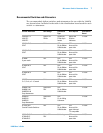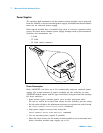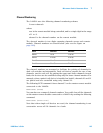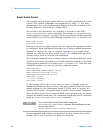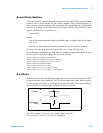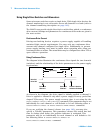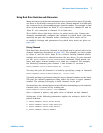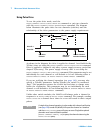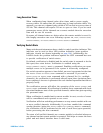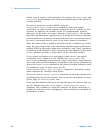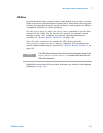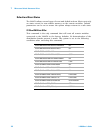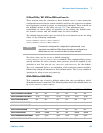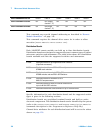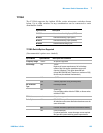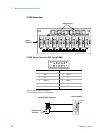Microwave Switch/Attenuator Driver 7
L4400 User’s Guide 149
Long Execution Times
When configuring long channel pulse drive times and/or power supply
recovery times, be aware that the results may be long execution times. For
example, you can set a channel pulse width of 255 ms and a recovery time of
255 ms. This channel will require 510 ms to open or close. If you set such
parameters across all the channels on a remote module then the execution
time will be over 30 seconds.
Be aware, all channel states are driven when the remote module is reset. So,
this lengthy execution can occur following a power on,
*RST, SYSTem:CPON,
SYSTem:PRESet, or ROUTe:RMODule:DRIVe:SOURce command.
Verifying Switch State
Many switches and attenuators have a built- in switch position indicator. This
indicator can be used to drive LED position indicators (some position
indicator circuits are shown beginning on page 184). Additionally, the
L4445A checks the position indicators against the SCPI command last sent
to provide verification of switch states.
By default, verification is disabled and the switch state is assumed to be the
last open/close state driven. Verification is enabled using the
ROUTe:CHANnel:VERify:ENABle command. Enabling verification can cause
multiple errors to be generated if the system is incorrectly configured.
If a switch operation appears to have failed, an error is generated at the time
the
ROUTe:CLOSe or ROUTe:OPEN command is executed. If you send a
ROUTe:CLOSe or ROUTe:OPEN command with a channel list (i.e., multiple
channels), the verification is performed after all open/close operations have
been completed. An error is generated for each channel operation that did not
properly verify.
The verification process will affect the operation of the
ROUTe:CLOSe? and
ROUTe:OPEN? commands. If verification is enabled, these commands will check
the actual hardware state of the specified channels, rather than just reporting
the presumed state.
When verification is enabled and a remote module is reset, a series of errors
will be consolidated and reported as one error.
Verification will slow switching performance on any remote module with one
or more verified channels. Additionally, if you have enabled the command
overlap function (using the
ROUTe:OPERation:OVERlap:ENABle command),
the verification will be performed at the end of each close/open operation,
before processing the next command.
The state of all verified channels on a remote module is refreshed whenever
any channel on that remote module is operated. This helps to ensure the front
panel and web based interface have a valid state.



